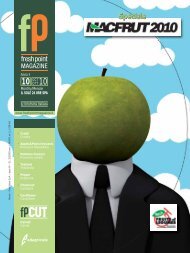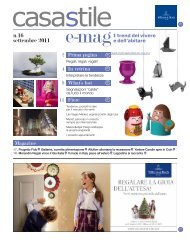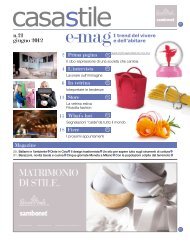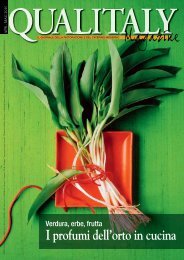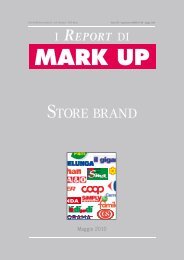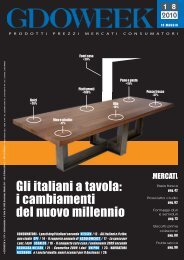Fresh Point Magazine - B2B24 - Il Sole 24 Ore
Fresh Point Magazine - B2B24 - Il Sole 24 Ore
Fresh Point Magazine - B2B24 - Il Sole 24 Ore
You also want an ePaper? Increase the reach of your titles
YUMPU automatically turns print PDFs into web optimized ePapers that Google loves.
produces carbonic acid, which will cause a drop in pH<br />
and create an acidifying effect. This acidification, as<br />
well as direct antimicrobial effects, can suppress the<br />
growth of many spoilage microorganisms and for this<br />
reason is essential in many extended shelf life packages».<br />
Expiring date<br />
On the importance of the expiring date as guarantee<br />
of quality we asked David Gombas, Senior Vice<br />
President - Food Safety and Technology United <strong>Fresh</strong><br />
Produce Association, Washington, DC.<br />
«It may only take one bad experience for a consumer<br />
to turn away from a product or brand. Expiration<br />
dates are one tool to avoid such an experience.<br />
Whether fresh-cut products intentionally have a<br />
short shelf-life (e.g., less than five days) or require<br />
the longest possible shelf-life (e.g., where products<br />
require extra time to reach their retail destination),<br />
expiration dates on the product package will assist<br />
retail handlers to rotate old product off the shelf and<br />
ensure consumers have only fresh product, with sufficient<br />
shelf-life to accommodate likely storage time<br />
and conditions in consumers’ homes and still provide<br />
a high quality product at consumption.<br />
Expiration dates will also assist consumers to avoid<br />
product that retail handlers may have missed, or that<br />
may have been in the consumer’s refrigerator longer<br />
than intended and may no longer have acceptable<br />
quality».<br />
Under ideal conditions, any fresh-cut product<br />
should achieve at least five days shelf-life. «Beyond<br />
that, fresh-cut operations should undertake a realistic<br />
study before setting an expiration date, considering<br />
particularly the likely range of initial produce<br />
quality and temperatures that the final product will<br />
experience in transport, storage, display and in consumers’<br />
hands. Overestimating shelf-life will result<br />
in poor experiences by some consumers; underestimating<br />
shelf-life can result in fewer sales than necessary».<br />
Books<br />
Bibliografia<br />
Brody, A.L., H. Zhuang, and J.H. Han<br />
(editors). 2011. Modified atmosphere<br />
packaging for fresh-cut fruits and vegetables.<br />
Wiley-Blackwell Publ., Ames,<br />
Iowa, 302 p. (http://www.wiley.com/Wi -<br />
leyCDA/WileyTitle/productCd-<br />
0813812747.html)<br />
Gorny, J. and J. Brandenburg. 2002.<br />
62 <strong>Fresh</strong> <strong>Point</strong> <strong>Magazine</strong> n.3 – march/marzo 2012<br />
Packaging Design for <strong>Fresh</strong>-Cut Pro -<br />
duce. Electronic download. United <strong>Fresh</strong><br />
Produce Association. This publication<br />
and others are available from UFPA<br />
(http://www2.unitedfresh.org/forms/sto<br />
re/ProductFormPublic/)<br />
Lamikanra, O. (editor). 2002. <strong>Fresh</strong>-cut<br />
fruits and vegetables: science, technology,<br />
livello di CO 2 nella confezione, l’anidride carbonica si<br />
dissolve nell’acqua producendo l’acido carbonico che<br />
causa un abbassamento del ph e un effetto acidificante.<br />
Tale acidificazione, insieme agli effetti antimicrobici<br />
diretti, può reprimere la crescita di molti microrganismi<br />
responsabili del deperimento ed è pertanto essenziale<br />
se si vuole estendere la shelf-life».<br />
La data di scadenza<br />
Sull’utilità della data di scadenza quale garanzia di qualità,<br />
abbiamo sentito David Gombas, vice presidente<br />
Sicurezza alimentare e tecnologie della United <strong>Fresh</strong><br />
Produce Association di Washington DC.<br />
«Le date di scadenza sono uno strumento per evitare ai<br />
consumatori cattive esperienze e, quindi, per evitare che<br />
si disamorino di un prodotto o di un marchio.<br />
Indipendentemente dalla durata della shelf-life, la data di<br />
scadenza sulla confezione aiuta i rivenditori a ruotare gli<br />
articoli in modo che i clienti abbiano sempre prodotti freschi<br />
con una durata sufficiente e tale da rispecchiare i<br />
probabili tempi di conservazione e da adattarsi alle condizioni<br />
presenti nelle case dei consumatori, affinché, al<br />
momento dell’apertura della confezione, essi godano di<br />
un prodotto di alta qualità. La data di scadenza è, infatti,<br />
utile anche agli stessi consumatori per identificare<br />
prodotti sfuggiti all’attenzione dei rivenditori o lasciati<br />
erroneamente troppo a lungo nel frigorifero dopo l’acquisto<br />
e pertanto non più accettabili da un punto di vista<br />
qualitativo».<br />
In condizioni ideali, spiega ancora Gombas, ogni prodotto<br />
fresco pronto per il consumo dovrebbe avere una<br />
shelf-life di almeno cinque giorni. «Oltre tale limite, prima<br />
di fissare una data di scadenza, si dovrebbero effettuare<br />
studi realistici che prendano in considerazione la possibile<br />
qualità iniziale e la temperatura a cui sarà potenzialmente<br />
sottoposto il prodotto finito durante trasporto,<br />
conservazione ed esposizione, nonché dopo l’acquisto.<br />
Una sopravvalutazione della shelf-life risulta, infatti, per<br />
alcuni clienti una cattiva esperienza, mentre una sua<br />
sottovaluzione potrebbe ostacolare le vendite».<br />
(Traduzione dall’inglese di <strong>Il</strong>aria Menna)<br />
and market. CRC Press, Boca Ra ton, FL,<br />
456 pp. (http://www.crc press.com/pro -<br />
duct/isbn/9781587160301)<br />
Martin-Belloso, O. and R. Soliva-Fortuny<br />
(eds). 2011. Advances in fresh-cut fruits<br />
and vegetables processing. CRC Press, Bo -<br />
ca Raton, FL, USA. (http://www.crcpress. -<br />
com/product/isbn/9781420071214)







